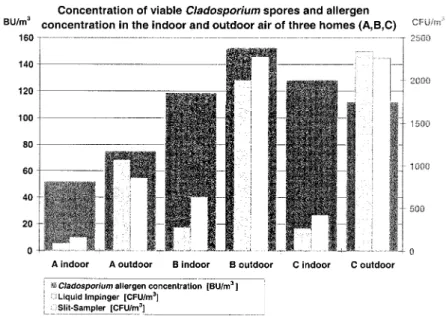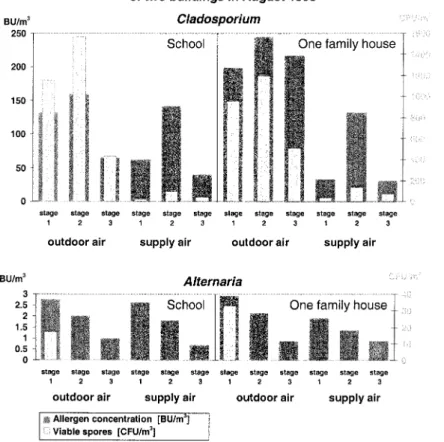Aerobiologia 16: 393–396, 2000.
© 2000 Kluwer Academic Publishers. Printed in the Netherlands. 393
Comparison of airborne spore concentrations and fungal allergen content
Barbara Flückiger
∗, Theo Koller & Christian Monn
Institute for Hygiene and Applied Physiology, Swiss Federal Institute of Technology, Zurich, Switzerland (∗Author for correspondence, e-mail: flueckiger@iha.bepr.ethz.ch; fax: +41 16321173)
Received 4 January 1999; accepted in final form 16 May 2000
Key words: airborne fungal allergens, Alternaria, Cladosporium, indoor air
Abstract
The exposure to spores causing health effects is usually assessed by determining the concentration of viable spores per cubic meter of air (CFU/m3). Since allergens might also be present in dead spores or smaller particles, the objective of this study was to investigate the correlation between the viable spores of Alternaria and Cladosporium at different indoor and outdoor sites and the corresponding allergen concentration detected with a specially developed ELISA (Enzyme Linked Immunosorbent Assay). In outdoor air, the results show a strong correlation between the different sampling techniques applied for viable spores (Slit-Sampler and Multistage Liquid Impinger) and between the viable spores and the allergen concentrations detected in the liquid samples of the impingers. Indoors, the number of viable spores and the allergen concentration do not correlate and the allergen load is underestimated if colony counting methods are used.
Introduction
Mould spores are found in large numbers in indoor and outdoor environments and they have been recog-nised as important inhalant allergens. Clinical studies are being performed to correlate symptoms of allergic patients to the concentrations of allergenic fungal spores (colony forming units CFU/m3 or the total spore counts) [DeKoster and Thorne, 1995; Cosentino and Palmas, 1996; Dotterud et al., 1996]. However, even in the absence of viable spores the air might carry allergens [ECA, 1993]. Allergenic proteins may be present in dead spores or in smaller fractions, similar to the findings that have been reported for various pollen allergens [Agarwal et al., 1984; Schäppi et al., 1996]. The objective of this study was to invest-igate if the concentrations of viable Alternaria and Cladosporium spores are a reliable indicator for the exposure to the respirable allergens of these moulds.
Materials and methods
Repeated air sampling was performed outdoors and in five mechanically and ten naturally ventilated build-ings. A Slit-Sampler (FH2, Loreco Reckert GmbH) with petri dishes containing malt extract agar (MEA; 30 g malt extract, 5 g peptone, 15 g agar, 1 l distilled water) was operated for the collection of viable spores in the air. In addition, sampling was carried out with Multistage Liquid Impingers [May, 1966] filled with phosphate buffered saline (containing 0,05% Tween 20) for size-selective sampling (the approximate cut-off points for the three stages are 6, 3.5 and 0.8 µm). The viable spore concentrations were determined by plating out three 1 ml samples from each stage of the impingers onto MEA. Together with the agar plates from the Slit-Sampler they were incubated for five days, colonies were counted and identified microscop-ically to genus level.
For the quantification of the airborne fungal aller-gens collected in the liquid impingers a direct compe-titive ELISA for Cladosporium herbarum and Altern-aria alternata was developed. Microtiter plates made
394
Figure 1. Concentration of viable Cladosporium spores and allergen concentration in the indoor and outdoor air of three naturally ventilated homes. The concentrations are averages of two samplings (May and July 1998).
of polystyrene with high protein affinity were coated with extracts of Alternaria and Cladosporium (Aller-gopharma Joachim Ganzer KG) diluted to 10 µg protein/ml. After blocking of the plates with buffer containing 1% bovine serum albumin, the samples from the liquid impingers or dilutions of the extracts for the standard curve were mixed with diluted serum from a patient allergic to Cladosporium (RAST class 3) or to Alternaria (RAST class 4), added to the plates and incubated for two hours at 37◦C. The remaining IgE-antibodies to Cladosporium or Alternaria, which had not reacted with the air samples and were there-fore free to be captured by the coated antigens, were detected with enzyme labelled (alkaline phos-phatase) mouse anti-human antibodies. The results are given in Biological Units (BU; defined by the Nordic Guidelines, 1989, and used to quantify the commercial extract used in this study: 5000 BU/vial) per m3of air. The sera used were tested for a large number of aller-gens and showed also reactivity against other alleraller-gens than the allergens of Cladosporium or Alternaria used in this study (e.g. grass pollen, animals). However, the design of the IgE-Inhibition ELISA suggests that possible cross-reactivity of the sera with unknown allergens in our samples will not show up. Cross-reactivity to other fungi known to produce similar allergens can not be eliminated, but the identification of the viable spores provides some information on the presence of such other fungi.
Results
The total viable spore concentrations obtained with the Slit-Sampler and the Multistage Liquid Impingers at all the investigated locations correlate strongly (Spearman rs = 0.85; p < 0.001). This is also the
case for viable Cladosporium spores sampled with both methods (rs= 0.90). During peak season slightly
higher concentrations of total viable spores (mainly Cladosporium) were sampled with the liquid impinger than with the Slit-Sampler. With the plated out liquid samples from the impingers less overgrowing occurred than on the Slit-Sampler agar plates. Since the sampling took place in summer an average of 80% (range 62–98%, no difference between sampling tech-niques) of the spores outdoors were Cladosporium. Alternaria made up only about 1% of all the viable spores collected with the Slit-Sampler and the liquid impinger.
Figure 1 represents the concentrations of viable spores obtained with the Slit-Sampler and the Multistage Liquid Impinger as well as the allergen concentrations sampled in the impingers and detected with the ELISA. The concentrations of viable Cladosporium spores and the Cladosporium allergen concentration in the indoor and outdoor air of three investigated homes with natural ventilation are shown. The allergen concentrations collected in the liquid impingers and detected with the ELISA did not always
395
Figure 2. Viable spore and allergen concentration for Cladosporium (top) and Alternaria (bottom) in the outdoor air and in the supply air of two mechanically ventilated buildings investigated in August 1998. The concentration for each of the stages (1–3) of the liquid impinger is given. The large Alternaria spores are all captured in stage 1 while smaller particles carrying Alternaria allergens are also collected in stages 2 and 3. Cladosporium allergen particles were collected on all three stages with most of the single spores in stage 2, clumps of spores in stage 1 and additional ill defined spore fractions such as allergen coated dust particles in stage 3.
correlate well with the viable spore concentrations in the samples. Comparing all the outdoor and the indoor samples of the investigated buildings a weak but significant correlation between the Cladosporium allergen concentration and the viable Cladosporium spores collected in the liquid impinger or the Slit-Sampler can be observed (both rs > 0.35; p < 0.05).
The allergen concentrations of Alternaria show only a correlation with the viable Alternaria spores on the Slit-Sampler agar plates (p < 0.05) and do not correlate with the viable spores in the liquid impinger. The separate analysis of indoor and outdoor measurements shows, that the correlation between viable spores and allergen concentration is always much stronger outdoors than indoors and that the relation of BU/CFU is much higher indoors than outdoors. For Cladosporium, the relation BU/CFU in the air of the naturally ventilated homes and the
outdoor air was significantly different (p < 0.01; indoor: Median 1.01, Max. 5.45; outdoor: 0.16, 2.47). For Alternaria in the homes and for Alternaria and Cladosporium in the supply air of the mechanically ventilated buildings the concentrations of the viable spores were extremely low and no correlation between the viable spore concentration and the allergen content could be observed. This finding is demonstrated in Figure 2 showing that in the supply air of the vent-ilation systems, no viable spores of Alternaria and Cladosporium or extremely low amounts were found while allergens could still be detected.
Discussion
Sampling with a liquid impinger followed by an ELISA analysis seems to be an appropriate way for
396
detecting fungal allergens in the air. A good correla-tion between allergen concentracorrela-tion and CFU/m3can be established for outdoor samples. It is interesting that a difference in the ratio of allergen concentration and viable spores between indoor and outdoor samples can be observed. The reasons for this finding in both naturally and mechanically ventilated buildings need to be investigated in more detail. The identification of the viable spores did not show higher indoor concen-trations of other fungi producing similar allergens which might cross-react in the ELISA. The relatively high indoor concentrations of allergens compared to the low CFU/m3 indicate that indoors the spores of Cladosporium or Alternaria may have lost their viab-ility while the allergens are still present and may contribute to an allergic reaction. The size fraction-ation indicates that outdoors as well as indoors a considerable amount of allergen might be present in dead spores, hyphae, small spore fragments or allergen coated dust particles.
Acknowledgements
The authors would like to thank Allergopharma Joachim Ganzer KG, Reinbek, Germany for providing the allergen extracts and all the building owners for their cooperation.
References
Agarwal M., Swanson, M., Reed, C. und Yunginger, J.: 1984, Airborne ragweed allergens: association with various particle sizes and short ragweed plant parts. J Allergy Clin Immunol
74(5), 687–93.
Cosentino, S. and Palmas, F.: 1996, Occurrence of fungal spores in the respiratory tract and homes of patients with positive skin test to fungi. Aerobiologia 12, 155–160.
DeKoster, J.A. and Thorne, P.S.: 1995, Bioaerosol Concentra-tions in Noncomplaint, Complaint, and Intervention Homes in the Midwest. American Industrial Hygiene Association 56(6), 573–580.
Dotterud, L.K., Vorland, L.H. and Falk, E.S.: 1996, Mould allergy in schoolchildren in relation to airborne fungi and residential char-acteristics in homes and schools in Northern Norway. Indoor Air
6(2), 71–76.
European Collaborative Action (ECA), 1993, Biological Particles in Indoor Environments. Commission of the European Comm-unities, Brussels.
May, K.R.: 1966, Multistage Liquid Impinger. Bacteriol. Rev. 30, 559–570.
Nordic Council on Medicines, 1989, Registration of allergenic preparations, Nordic guidelines, 2nd ed. No 23, Uppsala, NLN Publications, 1–34.
Schäppi G.F., Monn C., Wuthrich B. und Wanner H.U.: 1996, Direct determination of allergens in ambient aerosols: methodological aspects. Int Arch Allergy Immunol 110(4): 364–70.

